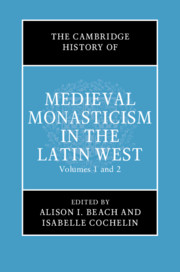58 results
A Companion to Medieval Rules and Customaries. Edited by Krijn Pansters. Brill's Companions to the Christian Tradition 93. Leiden: Brill, 2020. xi + 438 pp. $275.00 cloth.
-
- Journal:
- Church History / Volume 90 / Issue 4 / December 2021
- Published online by Cambridge University Press:
- 07 March 2022, pp. 939-940
- Print publication:
- December 2021
-
- Article
- Export citation
Chapter 2 - Living and Working in a Twelfth-Century Women’s Monastic Community
- from Part I - Life and Monastic Context
-
-
- Book:
- The Cambridge Companion to Hildegard of Bingen
- Published online:
- 28 October 2021
- Print publication:
- 04 November 2021, pp 37-51
-
- Chapter
- Export citation
Abbreviations
-
- Book:
- The Cambridge History of Medieval Monasticism in the Latin West
- Published online:
- 16 January 2020
- Print publication:
- 09 January 2020, pp xx-xxiv
-
- Chapter
- Export citation
Part IV - Forms of Monasticism in the Late Middle Ages
-
- Book:
- The Cambridge History of Medieval Monasticism in the Latin West
- Published online:
- 16 January 2020
- Print publication:
- 09 January 2020, pp 921-1190
-
- Chapter
- Export citation
29 - The Double Monastery as a Historiographical Problem (Fourth to Twelfth Century)
- from Part II - The Carolingians to the Eleventh Century
-
-
- Book:
- The Cambridge History of Medieval Monasticism in the Latin West
- Published online:
- 16 January 2020
- Print publication:
- 09 January 2020, pp 561-578
-
- Chapter
- Export citation

The Cambridge History of Medieval Monasticism in the Latin West
-
- Published online:
- 16 January 2020
- Print publication:
- 09 January 2020
Copyright page
-
- Book:
- The Cambridge History of Medieval Monasticism in the Latin West
- Published online:
- 16 January 2020
- Print publication:
- 09 January 2020, pp iv-iv
-
- Chapter
- Export citation
1 - General Introduction
-
-
- Book:
- The Cambridge History of Medieval Monasticism in the Latin West
- Published online:
- 16 January 2020
- Print publication:
- 09 January 2020, pp 1-16
-
- Chapter
- Export citation
Acknowledgments
-
- Book:
- The Cambridge History of Medieval Monasticism in the Latin West
- Published online:
- 16 January 2020
- Print publication:
- 09 January 2020, pp xix-xix
-
- Chapter
- Export citation
Contributors
-
- Book:
- The Cambridge History of Medieval Monasticism in the Latin West
- Published online:
- 16 January 2020
- Print publication:
- 09 January 2020, pp xv-xviii
-
- Chapter
- Export citation
Figures
-
- Book:
- The Cambridge History of Medieval Monasticism in the Latin West
- Published online:
- 16 January 2020
- Print publication:
- 09 January 2020, pp xii-xiv
-
- Chapter
- Export citation
62 - Research on Monasticism in the German Tradition
- from Part IV - Forms of Monasticism in the Late Middle Ages
-
-
- Book:
- The Cambridge History of Medieval Monasticism in the Latin West
- Published online:
- 16 January 2020
- Print publication:
- 09 January 2020, pp 1140-1153
-
- Chapter
- Export citation
The New Cambridge History of Medieval Monasticism in the Latin West
-
- Book:
- The Cambridge History of Medieval Monasticism in the Latin West
- Published online:
- 16 January 2020
- Print publication:
- 09 January 2020, pp ii-ii
-
- Chapter
- Export citation
Index
-
- Book:
- The Cambridge History of Medieval Monasticism in the Latin West
- Published online:
- 16 January 2020
- Print publication:
- 09 January 2020, pp 1191-1218
-
- Chapter
- Export citation
Part II - The Carolingians to the Eleventh Century
-
- Book:
- The Cambridge History of Medieval Monasticism in the Latin West
- Published online:
- 16 January 2020
- Print publication:
- 09 January 2020, pp 363-646
-
- Chapter
- Export citation
Part III - The Long Twelfth Century
-
- Book:
- The Cambridge History of Medieval Monasticism in the Latin West
- Published online:
- 16 January 2020
- Print publication:
- 09 January 2020, pp 647-920
-
- Chapter
- Export citation
43 - Gender and Monastic Liturgy in the Latin West (High and Late Middle Ages)
- from Part III - The Long Twelfth Century
-
-
- Book:
- The Cambridge History of Medieval Monasticism in the Latin West
- Published online:
- 16 January 2020
- Print publication:
- 09 January 2020, pp 803-815
-
- Chapter
- Export citation
Part I - The Origins of Christian Monasticism to the Eighth Century
-
- Book:
- The Cambridge History of Medieval Monasticism in the Latin West
- Published online:
- 16 January 2020
- Print publication:
- 09 January 2020, pp 17-362
-
- Chapter
- Export citation
Contents
-
- Book:
- The Cambridge History of Medieval Monasticism in the Latin West
- Published online:
- 16 January 2020
- Print publication:
- 09 January 2020, pp v-xi
-
- Chapter
- Export citation
Nuns’ Priests’ Tales: Men and Salvation in Medieval Women's Monastic Life. By Fiona J. Griffiths. Philadelphia: University of Pennsylvania Press, 2018. x + 360 pp. $69.95 cloth.
-
- Journal:
- Church History / Volume 88 / Issue 4 / December 2019
- Published online by Cambridge University Press:
- 19 December 2019, pp. 1048-1050
- Print publication:
- December 2019
-
- Article
- Export citation



